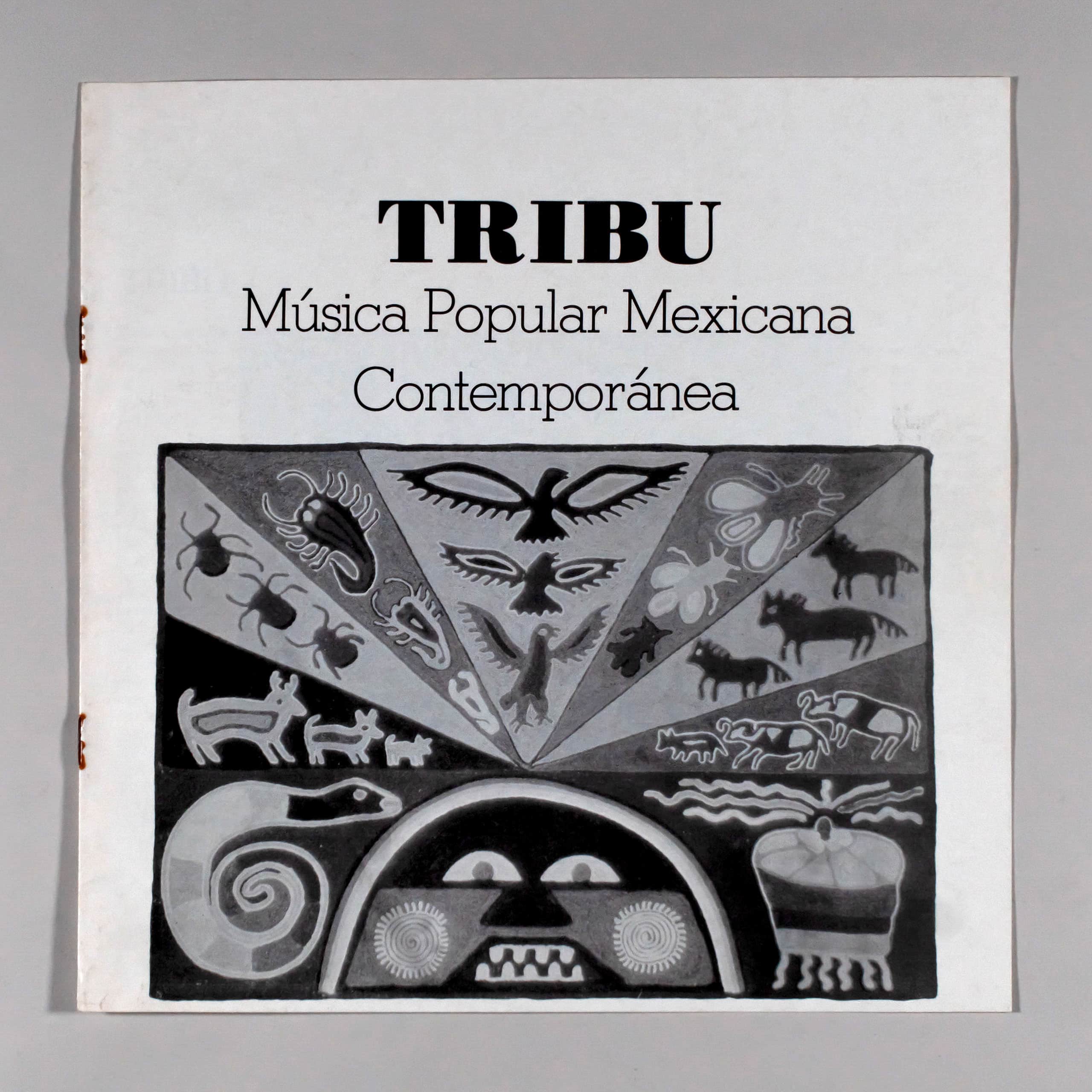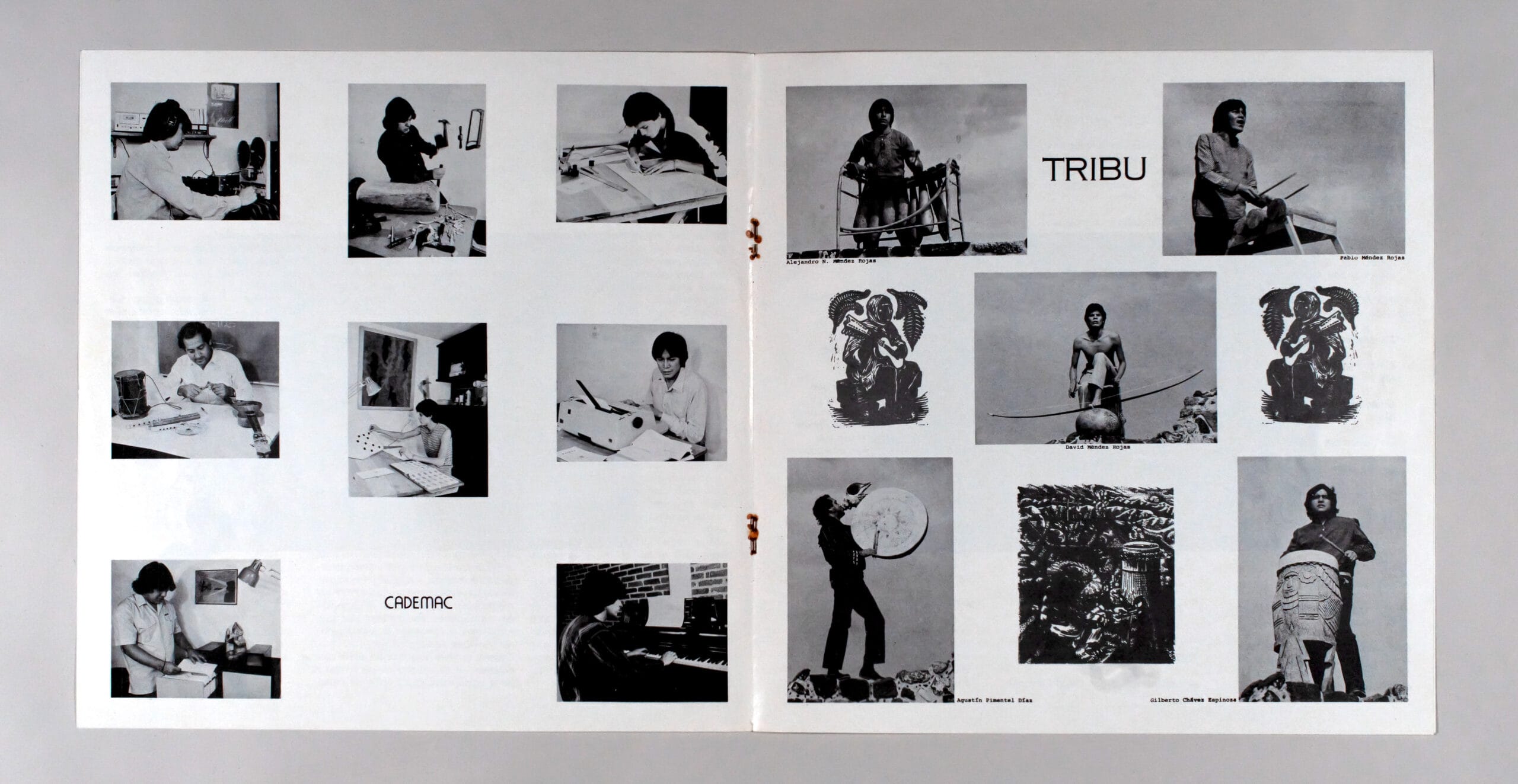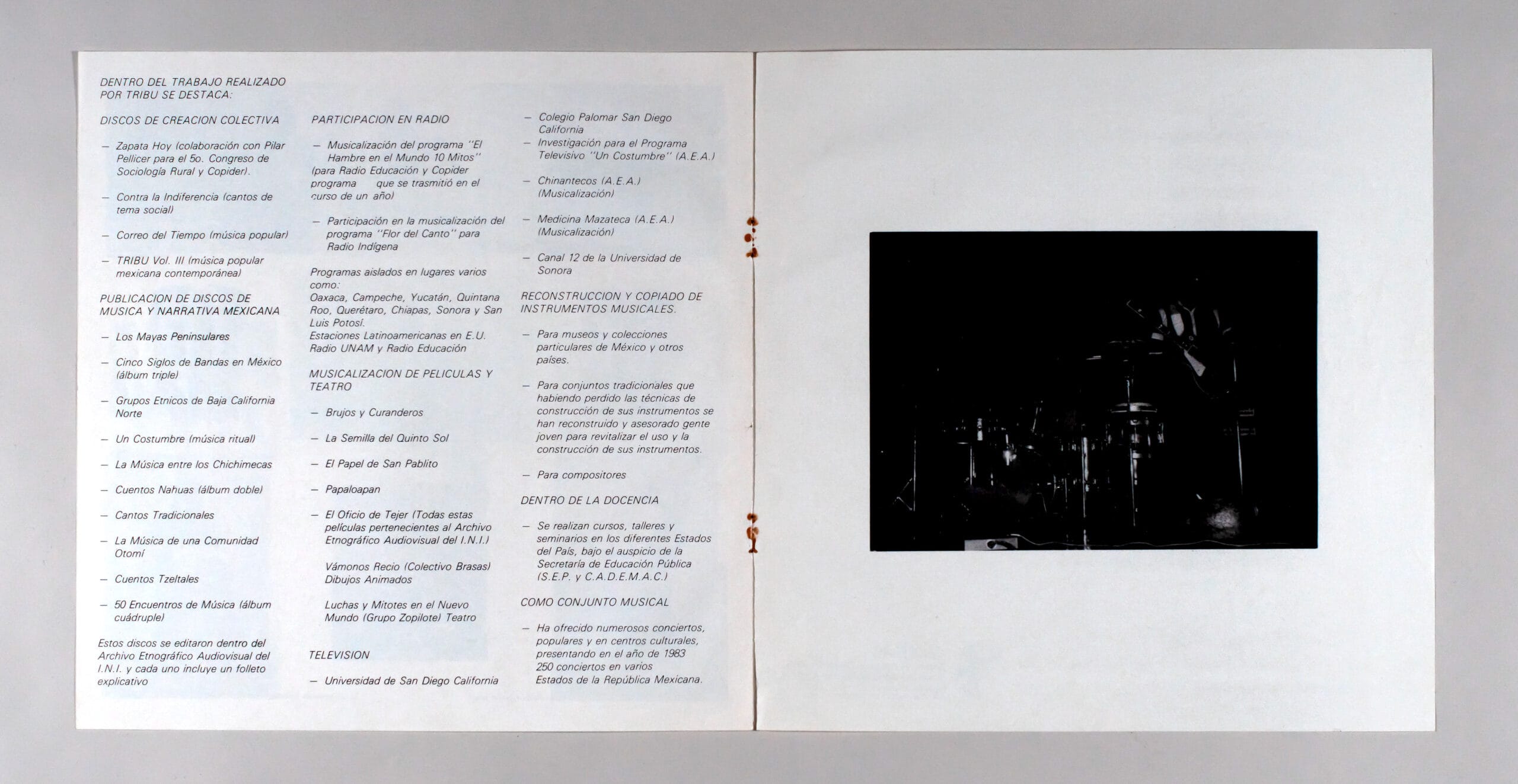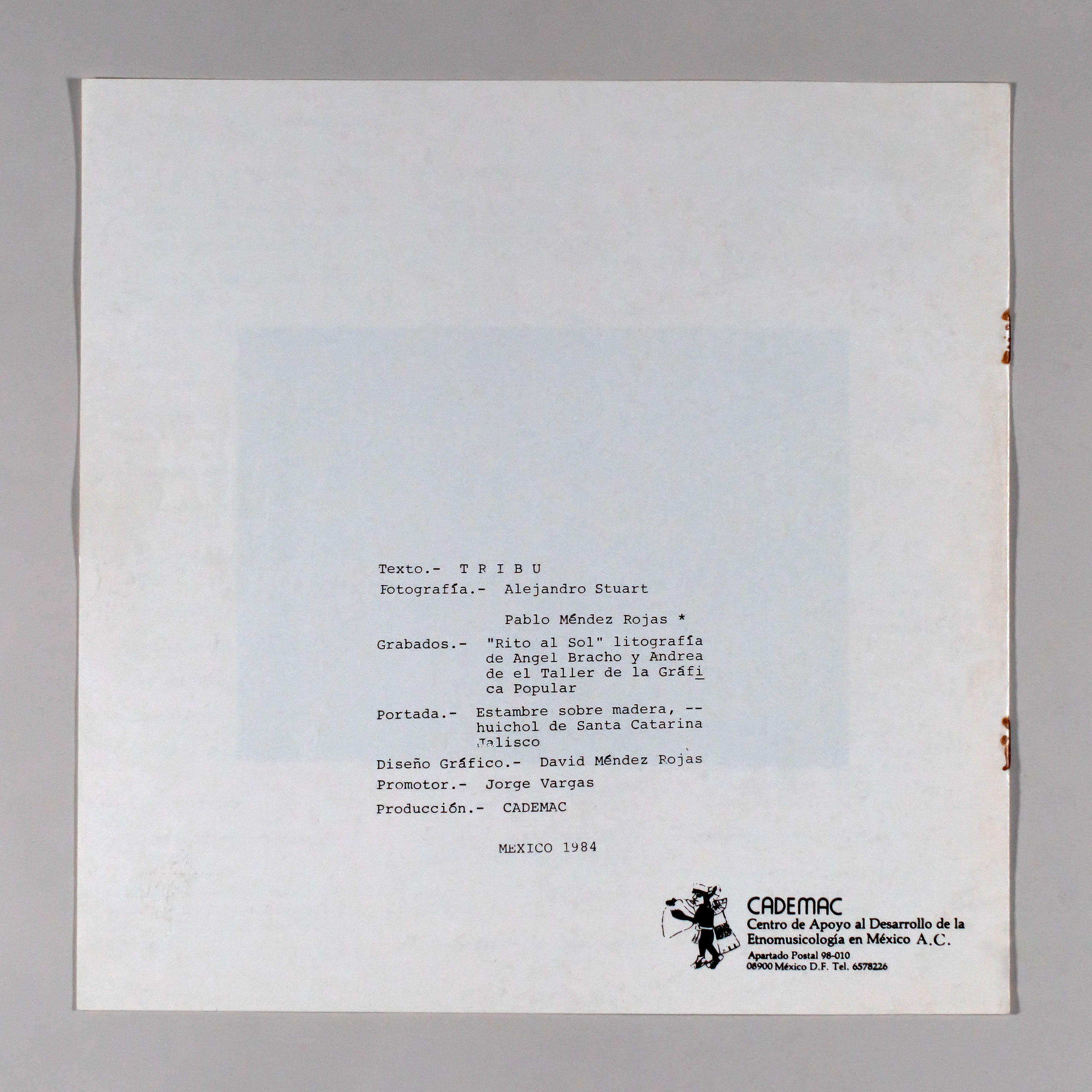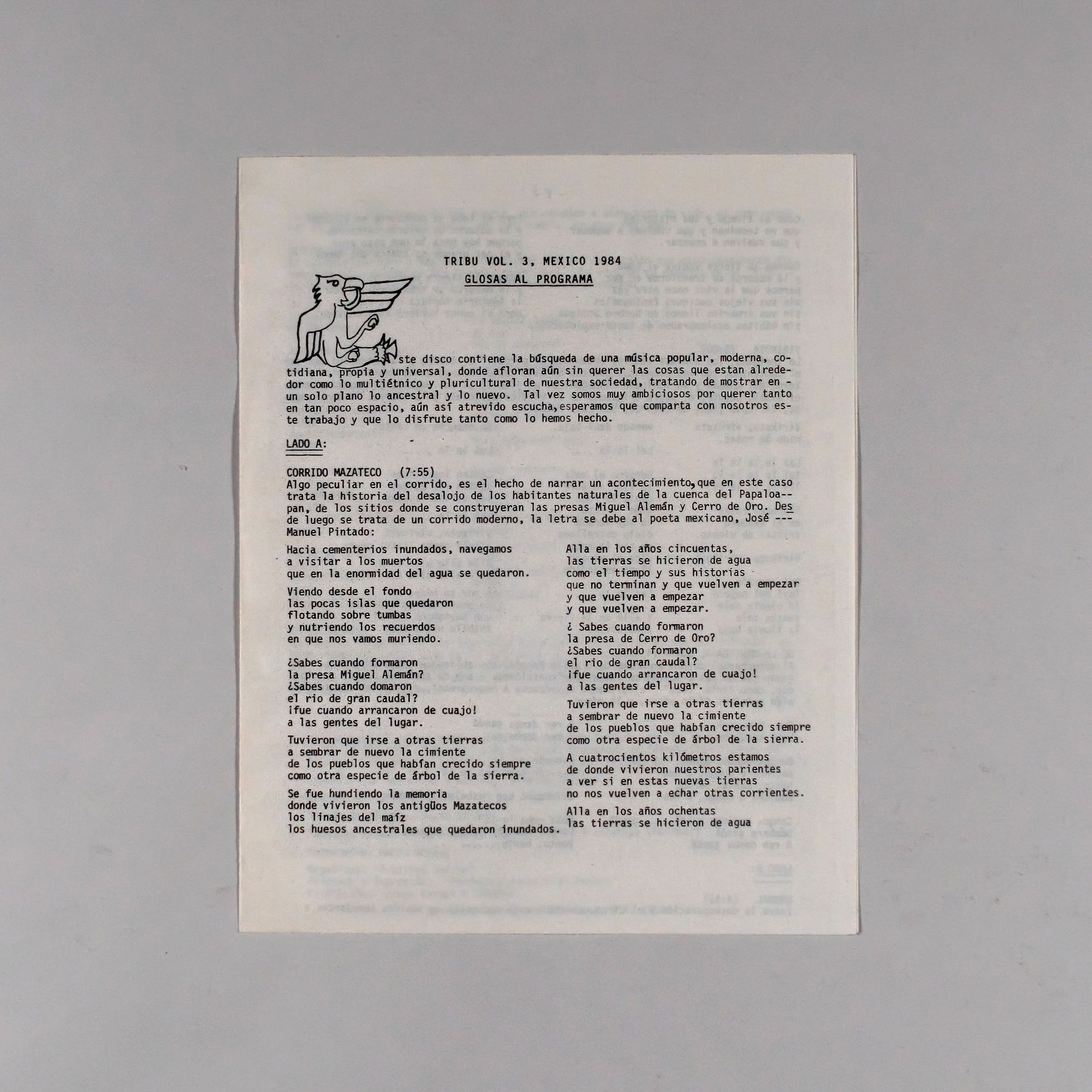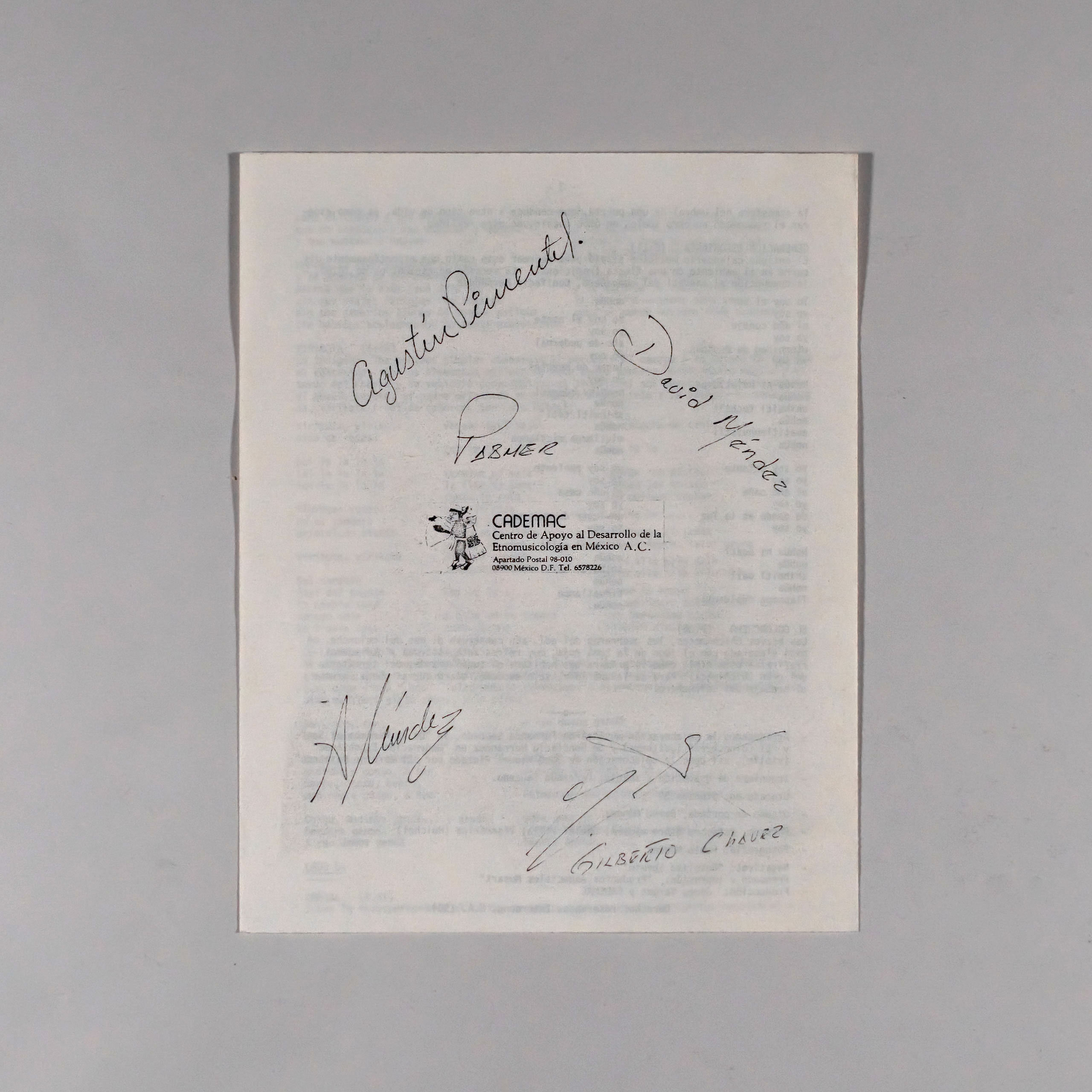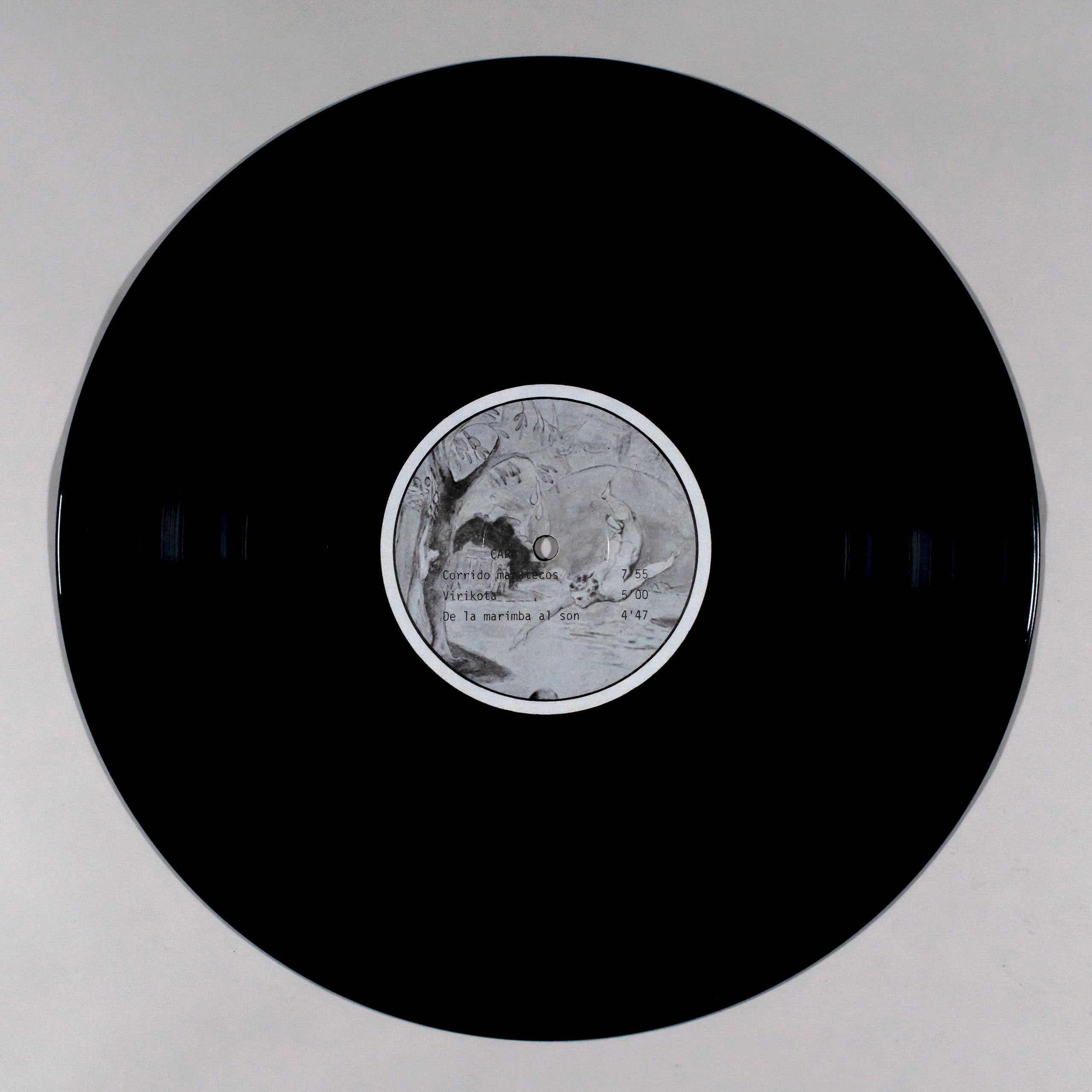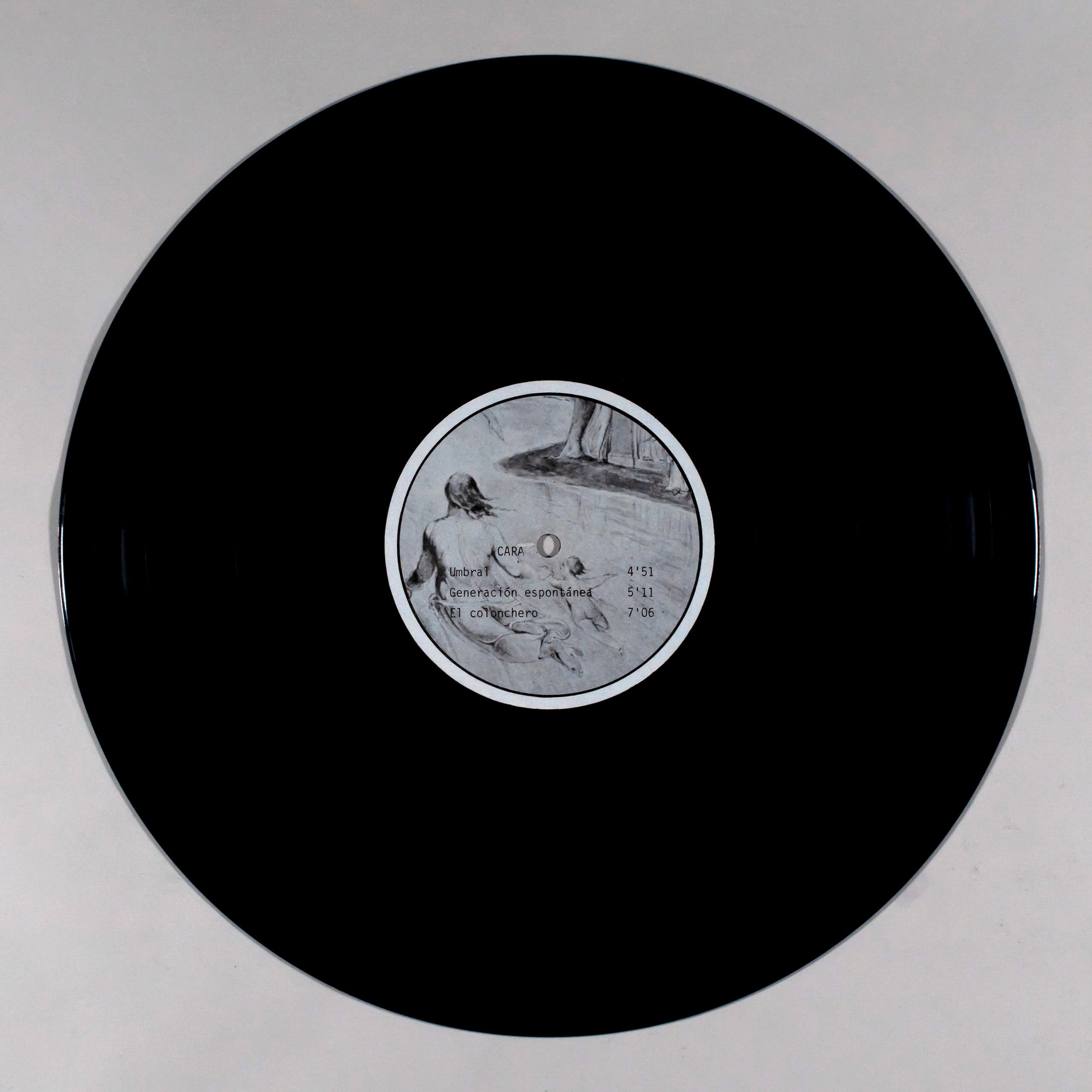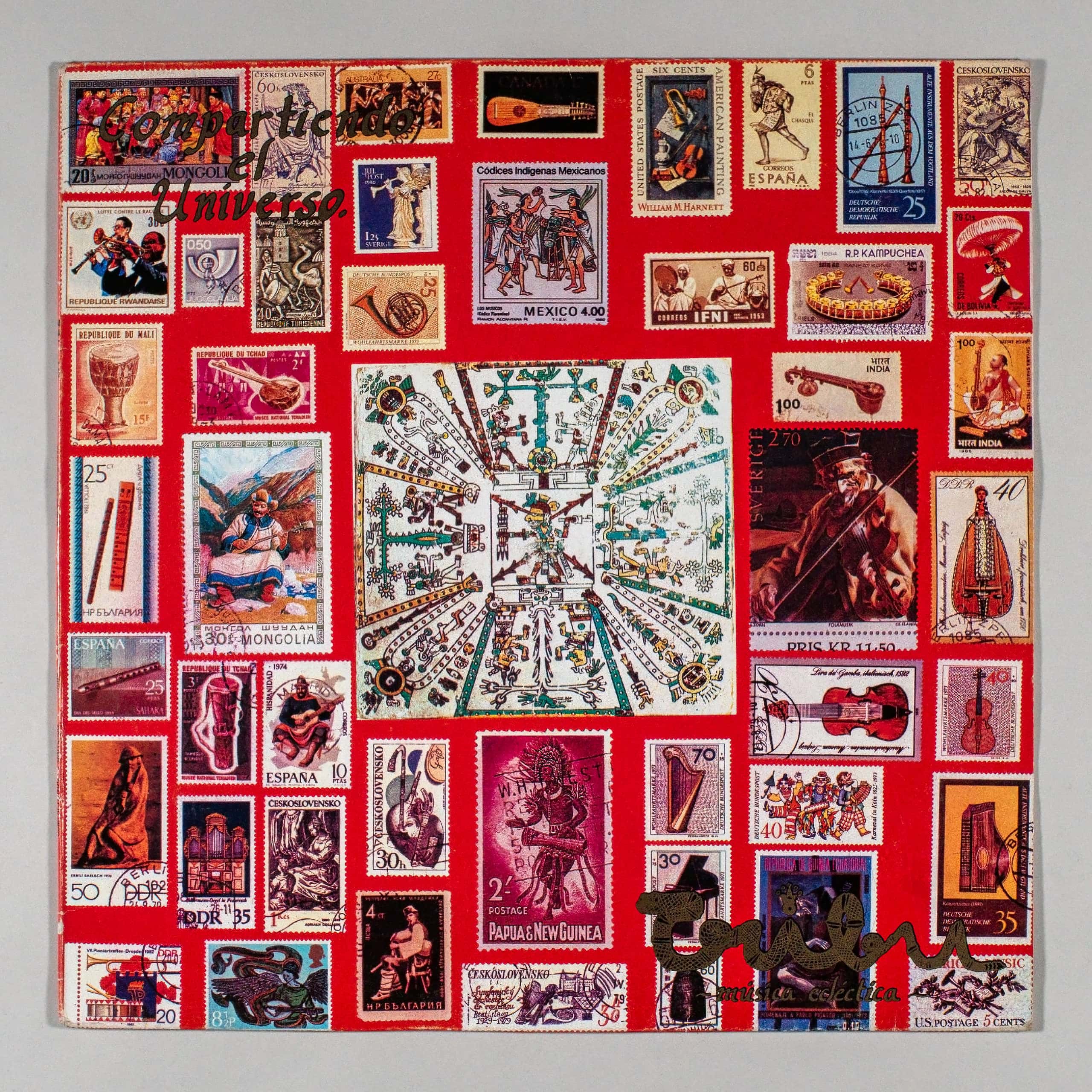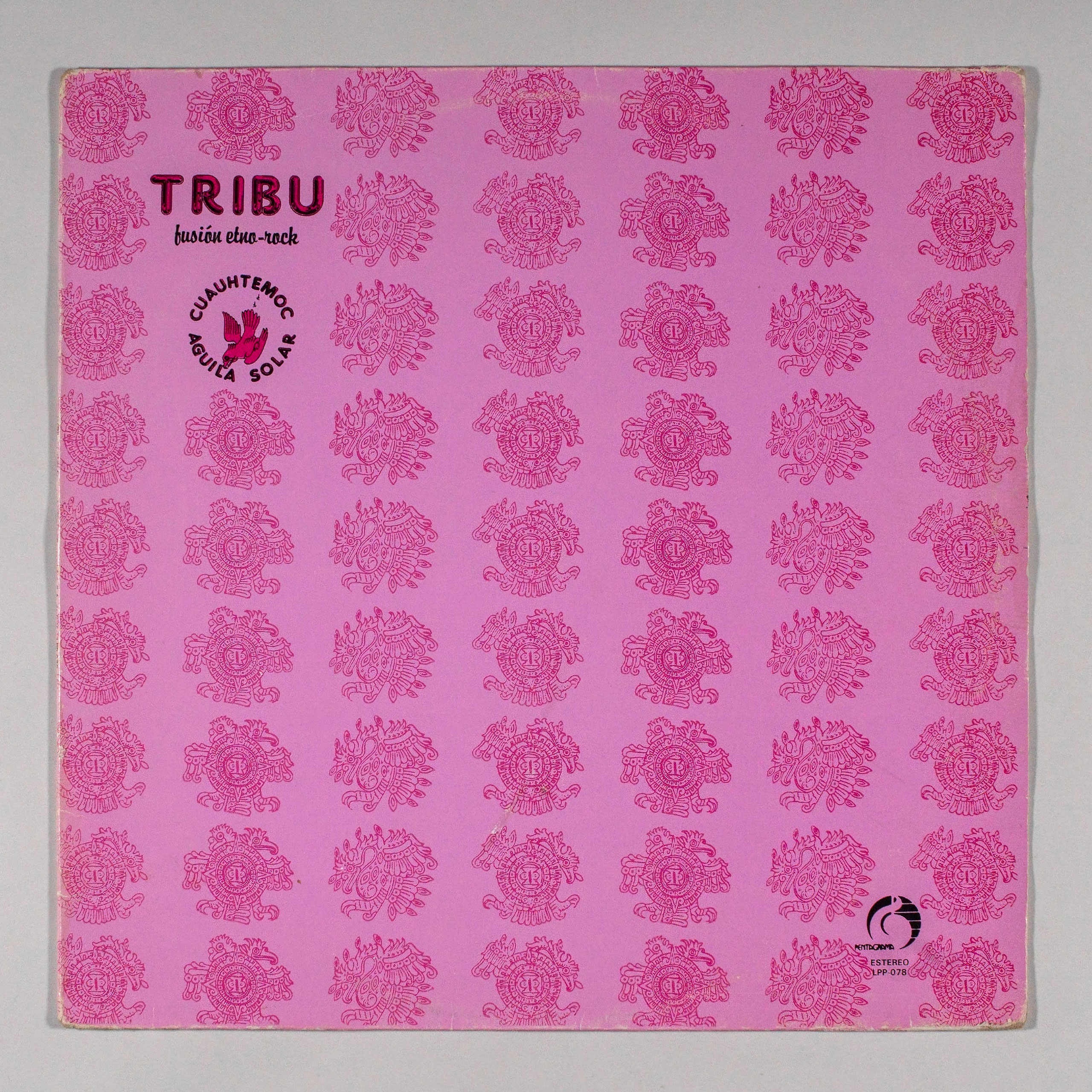CONTEMPORARY MEXICAN POPULAR MUSIC
TRIBU
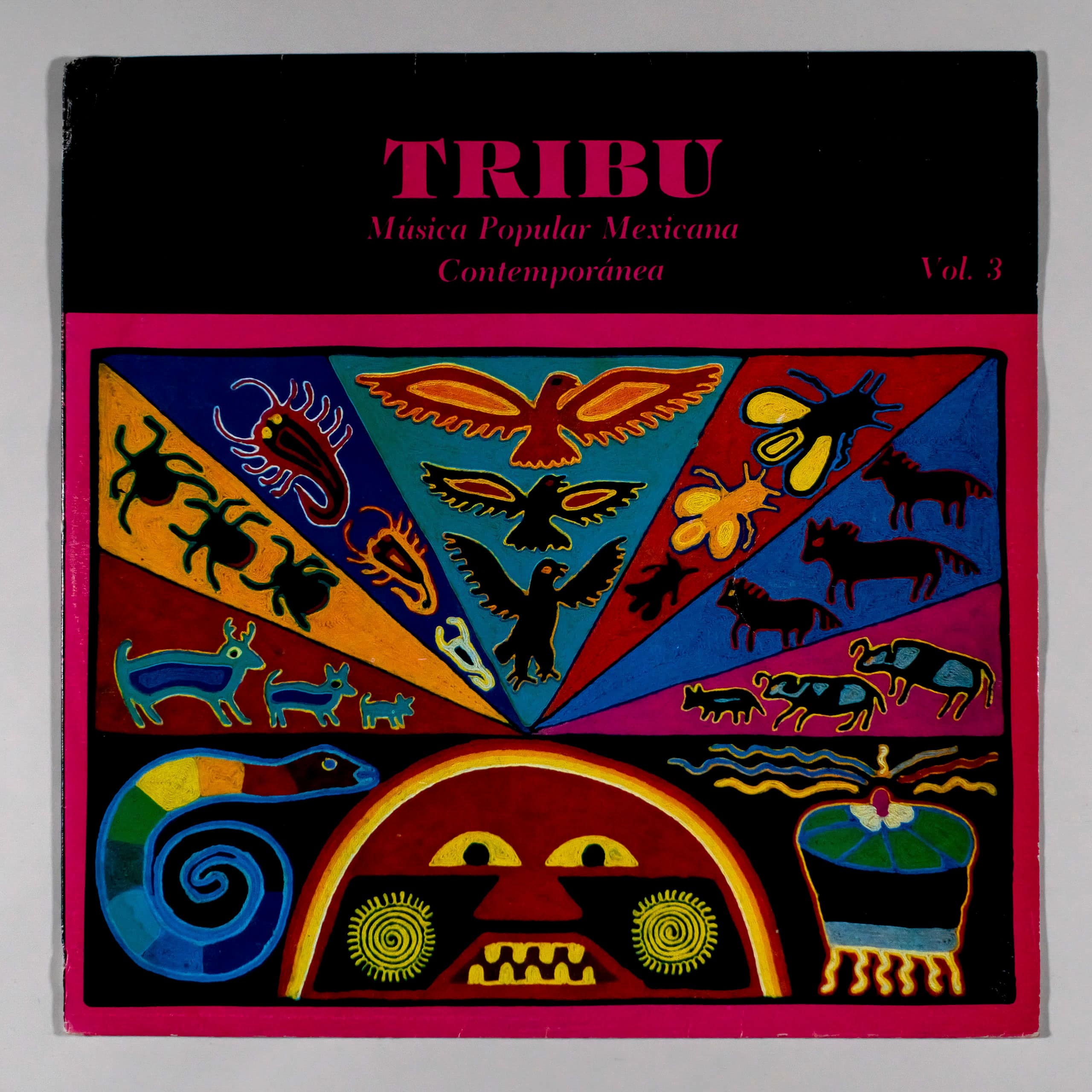
|
Label: CADEMAC MA-499 Format: Vinyl LP 12" 33 1/3 rpm Album Released: 1984 |
Country: Mexico |
Info:
TRIBU
Contemporary Mexican Popular Music
Vol. 3
TRIBU VOL. 3, MEXICO 1984
GLOSSES TO THE PROGRAM
This album contains the search for popular, modern, everyday, own and universal music, where the things that are around us like the multi-ethnic and multicultural aspects of our society still inadvertently emerge, trying to show the ancestral and the new on a single plane. Maybe we are too ambitious to want so much in so little space, still daring listen, we hope you share this work with us and enjoy it as much as we have.
SIDE A:
MAZATEC CORRIDO (7:55)
Something peculiar in the corrido is the fact that it narrates an event, which in this case deals with the eviction of the natural inhabitants of the Papaloapan basin, from the sites where the Miguel Alemán and Cerro de Oro dams were built. Of course It is a modern corrido, the lyrics are due to the Mexican poet, José Manuel Pintado:
To flooded cemeteries we sail
to visit the dead
that in the enormity of the water they stayed.
Watching from the bottom
the few islands that remained
floating over graves
and nurturing the memories
in which we are dying
Do you know when they formed?
the Miguel Alemán dam?
Do you know when they tamed
the river of great flow?
That was when they ripped off!
to the local people.
They had to go to other lands
to sow the seed again
of the towns that had always grown
like another species of tree of the sierra.
memory was sinking
where the ancient Mazatecos lived
the lineages of corn
the ancestral bones that were flooded.
back in the fifties,
the lands were made of water
like time and its stories
that do not end and that start again
and that they start again
and that they start again.
Do you know when they formed?
the Cerro de Oro dam?
Do you know when they formed?
the river of great flow?
It was when they ripped off!
to the local people.
They had to go to other lands
to sow the seed again
of the towns that had always grown
like another species of tree of the sierra.
We are four hundred kilometers
where our relatives lived
to see if in these new lands
no other currents throw us back.
back in the eighties
the lands were made of water
like time and its stories
that do not end and that start again
and that they start again.
When the land returns to the water
and the cob turns into a fish
it seems that life is born again
without their old ghostly chieftains
without their cupboards full of ancient hunger
without cramped habits of so much exploitation.
But the wolf turns into a shark
and the mojarra a severed salary
because what happened yesterday happens today
and the big fish gets stuck in the smaller one
When the land returns to the water
and the cob turns into a fish
the story begins again
as if it had never been told.
VIRIKOTA (5:00)
The indigenous, the simple sounds obtained by percussing the body and the intention more than the content, are the basic elements of this song immersed in the magical and eternal realm of the shaman and his cosmogonic vehicle, the jícuri, the peyote sun, the peyote deer , the peyote grandfather, the father originated in the vertex of heaven and earth, the sacred zone, Virikota (real de fourteen, San Luis Potosí).
Virikuta, virikuta
nest of roses
Lai la la la la
lai la la la la
lai la la la la
blooming roses
on the trail
wind glass.
Virikuta, virikuta
From the heart
oh! peyote
the mist comes out
deer comes out
the rain comes down
low blue deer
Lai la la …..
germinate the corn
the flower opens
sing the rose
moans the rose
I am deer
starry sky
I am the rose
says the deer
plain on.
Lai la la ……
and there on earth
divine zone
a song is heard.
Lai la la ……
the gods sing
the mountains sing
the hills sing
Lai la la ……
Virikuta, virikuta
jikuli neyra, tatei neyra
there, there, there, there, there
alle alle alle alle olle
for your huayo
your amarirera I love I fear
uuh huetamanu carimi
shibilo uiu you hua
FROM THE MARIMBA TO THE SON (4:47)
When listening to the homonymous story by Eraclio Zepeda, we inevitably force ourselves to imagine one of the first African American marimbas and one of those songs with which, as “Laco” would say “we happily began to black ourselves”, and inevitably we also wanted to hear it now, and we heard it.
They are, they are, they are
are, are, are
bantu, bantu, bantu,
madimba e congo, a hee
bantu, bantu, bantu,
madimba e congo, a hea
Congo, madimba gandá,…. gandá
bambara ganda
A ren damba ganda
a ren damba ganda
a ren damba ga
A-e-rón-da
a-e-rón-gare ten te ha
Chimbombo that slides, chimbombo
Umba umba ie ie
Congo, madimba gandá,…gandá
bantu, bantu,……
SIDE B:
THRESHOLD (4:51)
Between despair and the circus, this sequence of sounds is located, similar to the atmosphere of the threshold of a door, which leads to another type of life, it is like waiting for the readjustment in another soil, in another town, in another reality.
SPONTANEOUS GENERATION (5:11)
The old Mexican calendar served to recreate this song that spontaneously runs in the atmosphere of a traditional festival. The Spanish version is from TRIBU, the Nahuatl translation of compañero Bonifacio Hernández.
i am the south
I am
the year rabbit
I am
eternity of thorns
I am
nohüa ni huistlampa
nohua
shihuitl tochtli
nohua
cuatitlanhuistli
nohua
i am orient
I am
the year cane
I am
where is the light from
I am
nohua ni acatl
nohua
shihuitl oatl
nohua
tlapcopa cualcantla
nohua
I am the north
I am
flint year
I am
place of the dead
I am
NohüaNi técpatl
nohua
shihuitl tetl
nohua
mictlampa mictlampa
nohua
I am west
I am
the year home
I am
a place of women
I am
nohua ni calli
nohua
shihuitl calli
nohua
cihuatlampa
nohüa
THE COLONCHERO (7:06)
The brave Chichimecas, the warriors of the sun, still use the colonche, a drink made with the juice of the red tuna, very refreshing, tasty and which also reaffirms this ethnic group as the first to inhabit the large tunnel, in the territory of the great Chichimeca. To give you an idea, just listen, of course, if you can, try the colonchero’s concoction.
—o—
- We are grateful for the musical collaboration of Fernando Saucedo, in “De la Marimba al Son” and “El Colonchero” (guitar) and of Bonifacio Hernández in “Generación Espontanea” (violin), as well as the collaboration of José Manuel Pintado for “El Corrido Mazateco “.
- Recording and mixing engineer; Fernando Saucedo.
- Recorded in; “Studio 59”
- Cover design; david mendez
- Front page; Yarn on wood, Daniel Villa, Visrrárica (Huichol)
- Photography; Pablo Mendez
- Negatives; “Servin Photolith”
- Pressing and printing; “Special Musart Products”
- Production; Jorge Vargas and CADEMAC
All rights reserved Intersong, S.A. 1984.
TRIBU
Finding a definition for those of us who group together under the name of TRIBU is not difficult, but it cannot be achieved with a few words either, since the activities and interests pursued are diverse.
What can be more easily noticed is that we are a group (musician) whose repertoire is made up of musical examples that could be placed in the field of contemporary Mexican popular music.
Basically we use elements of the Mexican tradition, combining attitudes and musical genres from the broad taxonomy that exists in this country, enriching them with modern music and instruments.
This of course would not have much significance if it were only a copy. What is attractive in any case is that they are only used as a source of information to convert them into an expression that shows us ourselves. Of course we do not find reasons not to use other instruments and possibilities that the world of modern technology offers us.
The members of TRIBU carry out studies in different branches of Ethnomusicology at the National School of Music of the UNAM, but disappointed by the null importance that the authorities give to this science, since they have even come to ignore the career, we have decided to follow a self-taught training.
To achieve this, it has been necessary to study J traditional Mexican music, as well as Ethnomusicology in general, for which we develop our activities within the Center for Support for the Development of Ethnomusicology in Mexico A.C., CADEMAC, where research, Field work, office work, design, recordings are done, material is archived and documented, its dissemination is sought, the necessary instruments are built and the information is transmitted, with which two objectives are achieved: one, the collection, the dissemination and revitalization of materials. On the other hand, a collective search work for the composition is attempted.
Regarding the dissemination work, at TRIBU we have been preparing audiovisual materials, giving seminars, musicalizing films, radio and television programs, LIVE presentations, and carrying out all activities that allow us to show the richness of Mexican music.
TRIBU currently tours throughout the Mexican Republic presenting its musical show, and sometimes giving seminars for high school teachers, seeking the creation of professional associations that strengthen the training of researchers and research centers.
It also observes an active relationship with cooperatives of field and communication workers, as well as workers in general.
The aforementioned works are combined with the publication of their fourth album and with the work they do at CADEMAC.
On the other hand, TRIBU, as an independent group, has considered it important to create sources of work that allow both them and other similar groups to have constant activity, which is why they have created the “LA COYOTA” tent, which presents popular shows throughout the Mexican Republic.
WITHIN THE WORK CARRIED OUT BY TRIBU THE FOLLOWING ARE:
COLLECTIVE CREATION RECORDS
- Zapata Hoy (collaboration with Pilar Pellicer for the 50th Rural Sociology Congress and Copider).
- Against Indifference (songs with a social theme)
- Time Mail (popular music)
- TRIBU Vol. III (contemporary Mexican popular music)
PUBLICATION OF MEXICAN MUSIC AND NARRATIVE RECORDS
- The Peninsular Mayas
- Five Centuries of Bands in Mexico (triple album)
- Ethnic Groups of Baja California Norte
- A Custom (ritual music)
- Music among the Chichimecas
- Nahuas Tales (double album)
- Traditional songs
- The Music of an Otomi Community
- Tzeltal tales
- 50 Music Encounters (quadruple album)
These records were published within the Audiovisual Ethnographic Archive of the I.N.I. and each one includes an explanatory brochure.
RADIO PARTICIPATION
- Musicalization of the program “El Hambre en el Mundo 10 Mitos” (for Radio Educación and Copider program that was transmitted in the course of a year)
- Participation in the musicalization of the program “Flor del Canto” for Radio Indígena
Isolated programs in various places such as: Oaxaca, Campeche, Yucatán, Quintana Roo, Querétaro, Chiapas, Sonora and San Luis Potosí. Latin American stations in the U.S. Radio UNAM and Radio Education
MUSICALIZATION OF FILM AND THEATER
- Sorcerers and Healers
- The Seed of the Fifth Sun
- The Role of Saint Paul
- Papaloapan
- The Craft of Weaving (All these films belonging to the I.N.I. Audiovisual Ethnographic Archive)
- Let’s Go Recio (Colectivo Brasas) Cartoons
- Fights and Mitotes in the New World (Zopilotel Theater Group
TELEVISION
- University of San Diego California
- Palomar College San Diego California
- Investigation for the Television Program “Un Costumbre” (A.E.A.)
- Chinantecos (A.E.A.) (musicalization)
- Mazateca Medicine (A.E.A.) (Musicalization)
- Channel 12 of the University of Sonora
RECONSTRUCTION AND COPYING OF MUSICAL INSTRUMENTS.
- For museums and private collections in Mexico and other countries.
- For traditional ensembles that, having lost the construction techniques of their instruments, young people have been rebuilt and advised to revitalize the use and construction of their instruments.
- For composers.
INSIDE TEACHING
- Courses, workshops and seminars are held in the different States of the Country, under the auspices of the Ministry of Public Education (S.E.P. and C.A.D.E.M.A.C.)
AS A MUSICAL ENSEMBLE
- It has offered numerous concerts, popular and in cultural centers, presenting in the year 1983 250 concerts in various states of the Mexican Republic.
Text.- TRIBU
Photography.- Alejandro Stuart, Pablo Méndez Rojas *
Engravings.- “Rite to the Sun” lithograph by Angel Bracho and Andrea from the Taller de la Gráfica Popular
Cover.- Yarn on wood, — Huichol of Santa Catarina, Jalisco
Graphic Design.- David Méndez Rojas
Promoter.- Jorge Vargas
Production. -CADEMAC
© 1984
CADEMAC
Support Center for the Development of Ethnomusicology in Mexico A.C.
PO Box 98-010
08900 Mexico City Tel. 6578226
FACE A
Mazatec corrido 7:55
Virikota 5:00
From the marimba to the sound 4:49
B-SIDE
Threshold 4:51
Spontaneous generation 5:11
The settler 7:06
Tracklist:
CONTEMPORARY MEXICAN POPULAR MUSIC
SIDE 1
- A1 Mazatec Corrido 7:55
Performer(s): TRIBU - A2 Virikota 5:00
Performer(s): TRIBU - A3 From the marimba to the sound 4:49
Performer(s): TRIBU
SIDE 2
- B1 Threshold 4:51
Performer(s): TRIBU - B2 Spontaneous generation 5:11
Performer(s): TRIBU - B3 The settler 7:06
Performer(s): TRIBU
Credits:
Recording and mixing engineer; Fernando Saucedo.
Recorded in; “Studio 59”
Engravings.- “Rite to the Sun” lithograph by Angel Bracho and Andrea from the Taller de la Gráfica Popular
Cover design; David Méndez.- Yarn on wood, — Huichol of Santa Catarina, Jalisco
Graphic Design.- David Méndez Rojas
Front page; Yarn on wood, Daniel Villa, Visrrárica (Huichol)
Photography; Alejandro Stuart, Pablo Mendez Rojas
negatives; “Servin Photolith”
Pressing and printing; “Special Musart Products”
Production; Jorge Vargas and CADEMAC
Text.- TRIBE
Promoter.- Jorge Vargas
Production. -CADEMAC
Notes:
We are grateful for the musical collaboration of Fernando Saucedo, in “De la Marimba al Son” and “El Colonchero” (guitar) and of Bonifacio Hernández in “Generación Espontanea” (violin), as well as the collaboration of José Manuel Pintado for “Mazatec Corrido”.








